Adaptive Innovation in the Ukraine Humanitarian Response: How Context, Leadership and Partnerships Matter

The case study ‘Adaptive Innovation in the Ukraine Humanitarian Response: How Context, Leadership and Partnerships Matter’ paints a picture of how the humanitarian community has used and engaged with research, evidence and innovation in the first year of the response to the crisis in Ukraine. This assignment is a part of Elrha’s Global Prioritisation Exercise (GPE) for Humanitarian Research and Innovation.
Russia’s re-invasion of Ukraine in February 2022 caused a massive humanitarian emergency with an estimated 17.7 million people in urgent need of humanitarian aid. Ukraine was a new country of operation for most humanitarian agencies, and for Ukranian organisations the crisis presented a new context. This led to significant scaling up and uncertainty in the humanitarian response to the crisis.
Key findings from the case study:
- The innovation that took place was mostly ‘adaptive’. There was little to no invention-driven innovation. Nearly all innovations were born of collaborations, often stemming from established and trusted partnerships. Multiple examples of these innovations were mostly related to digitalisation, technical innovation and process innovation.
- Internal rules and procedures acted as brakes on innovation by limiting risk-taking in many cases. Senior, trusted leaders were required to get the necessary organisational buy-in to take the risks that any new way of working requires. Furthermore, an active civil society was an enabler of programme adaptations, but due diligence requirements of international agencies were a hindrance.
- Existing coordination structures are focused on operational humanitarian response. They do not bridge the lack of relationship between Ukranian research bodies and the international humanitarian sector, but potential exists to facilitate collaborations.
- Flexible funding is a key enabler and the lack of it, a key barrier.
Based on the experiences highlighted in the case study, the key recommendations are:
- Operational agencies should deploy senior, trusted leaders to scale-up and improve adaptive capacity.
- Coordination mechanisms should include the identification of key questions that would benefit from targeted research and innovation.
- For greater localisation and engagement, international humanitarian agencies should seek to map, identify and partner with Ukranian research bodies.
- Donors can enable more innovation by making funding mechanisms simpler or providing more support for bodies that are not used to applying for such contracts.
This study was led and co-authored by Nigel Timmins (Humanitarian Consultant) and Anton Shevchenko (Independent Consultant). 33 semi-structured interviews were conducted with key informants. The consultants contacted a range of international agencies operational in Ukraine, the water, sanitation and hygiene (WASH) and health clusters in-country, the State Emergency Service of Ukraine, and national actors identified in the Disasters Emergency Committee-funded Ukraine Humanitarian Appeal Scoping Exercise – they in turn suggested people to speak with. This case study is not a systematic study, but it offers good anecdotal evidence of significant innovation that is taking place within a hugely demanding response context. There is less evidence of original research, but that is unsurprising at this stage in a humanitarian response.
[.slimline-cta-box][.slimline-cta_heading]What is the Global Prioritisation Exercise?[.slimline-cta_heading][.slimline-cta_paragraph]The Global Prioritisation Exercise (GPE) aims to improve outcomes for people affected by crisis by amplifying the impact of investments in research and innovation and understanding the priorities at all levels. It will provide a detailed overview of the progress and performance of the humanitarian research and innovation ecosystem with a clear set of priorities for research and innovation funding and attention.
Find out more about the GPE[.slimline-cta_paragraph][.slimline-cta-box]